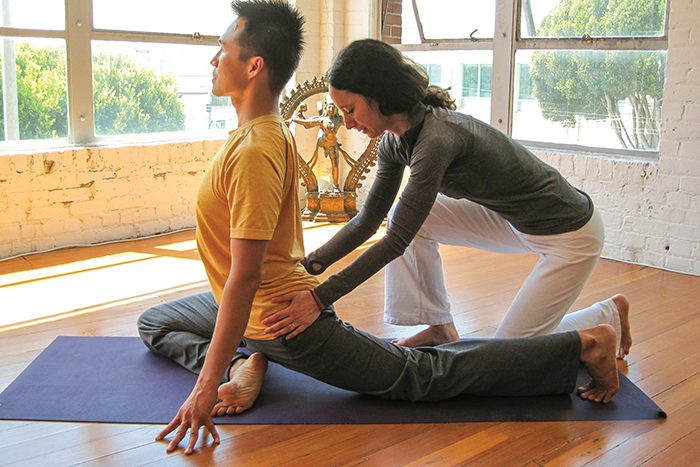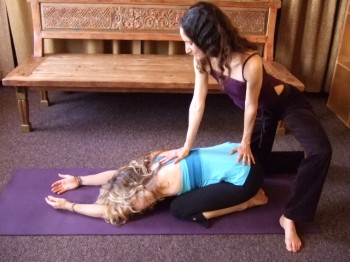Know Your Edge: How to Stave Off Yoga Injuries

We know you might love yoga, but should you be worried about injuries caused by your practice?
According to a recent article in The New York Times, there is a rise in hip injuries among women who practice yoga today. The more common injury, known as FAI (Femoroacetabular Impingement), stems from repeat grinding of the hip socket by the upper thigh bone. Women are disproportionately affected by FAI and other yoga-related injuries due to their wider range of motion and elasticity.
How can you steer clear of a yoga stretch gone awry? According to Jill Abelson, a bi-coastal Advanced Certified Jivamukti Yoga teacher who was listed by Yoga Journal as one of the “Five Yogis Changing the World,” it’s important to know your limits and to ask for help from your instructor when you need it. Abelson, author of EXTRA LOVE: The Art of Hands-on Assists: Hips, Twists, and Forward Bends, is renowned for her expertise in alignment, injury prevention and the art of hands-on assists.
Who should be concerned about injury prevention while doing yoga? “Everyone,” says Abelson. “Teachers and students should be concerned about injury prevention. The economics of yoga is trending away from traditional, individualized instruction toward bigger classes, just as newer, less experienced teachers are entering the workforce. Larger classes + less experienced teachers creates a very challenging situation on both sides.”
She also adds that the The “No Pain, No Gain” mentality is making yoga more dangerous today. Pain arises as a warning sign before an injury occurs. “Yoga students should never push through pain or ignore a nagging injury,” says Abelson.
To help you know your limits—and when to ask for help—yoga guru Abelson provides us with a few tips:
How can yogis tell the difference between intense feeling/stretching and actual pain?
There’s a fine line between intense feeling/stretching and actual pain, and sometimes it’s hard to tell the difference. As a yoga practice advances, eventually yogis learn to decipher intense feeling or sensation (working at your edge) compared with actual pain. Intensity would feel like working at your edge, muscles may be “burning,” but you’re not risking injury. In other words, discomfort would stop when you release the pose. Actual pain would register as a severe, sharp, throbbing, pulling, pinching or tearing sensation.
How can yogis know how far to push themselves?
Rule of thumb: never push beyond the point of “deterioration,” meaning when the pose starts to crumble or lose its foundation, form, or alignment. Then you’ve pushed too far. The more you know your body, the better you can gauge your “edge.”
What are the most common yoga injuries?
Too much flexibility creates instability, and typically leads to joint-related injuries—wrists, shoulders and lower back. Recent news reports highlighted hip joint injuries among flexible students who push too far in certain poses. Conversely, too much strength creates a tighter, more rigid body; these students are more prone to soft tissue injuries like muscle and tendon pulls or strains. The most common injuries I’ve seen by far are progressive injuries of the wrist, shoulder and lower back, directly related to “overdoing” Sun Salutations. I also often see hamstring-related injuries related to over-stretching.
Over the past 2 years, I sustained 3 serious neck injuries from teachers and teaching assistants who didn’t know how to help me properly in class. Two of the injuries were in the most basic, gentle poses you can imagine—child’s pose and corpse pose. The third was in headstand, after which I ended up in the emergency room. The child’s pose injury took months to resolve, involving repeat trips to the doctor and expensive MRI and MRA scans to rule out vascular damage. While not common, these injuries could happen to anyone.
Why do hyper-flexible students need extra attention?
Hyper-flexible students need “extra love” and attention. I talk about this A LOT in my trainings, especially in the context of weight-bearing poses like Down Dog, Plank, and Wheel. Too much flexibility can create instability, and typically leads to joint-related injuries—wrists, shoulders and lower back. The body just bends naturally, and the joints bear all the pressure.
Teachers should and must get to know their students’ normal range of motion, so they help gauge how much is too much on any given day. I always point out hyper-extension if I suspect a chronic condition or chance for progressive injury. Knowledge and observation helps keeps students safe.
What is your favorite yoga position right now?
My favorite pose now is Extended Triangle Pose. I love the way it stretches the side body.
Kamagra oral jelly Online something to buy the most convenient way. He doesn’t demand from you any actions except how to visit the website. And in separate with goods necessary to you to put the end. To specify your address and to wait for the supplier to whom you will give money.





January 14th, 2014 at 6:21 pm
dear erinn, thank you for promoting this story!! wishing you an your readers a happy new year! jill
January 14th, 2014 at 8:32 pm
Hi Jill! Thank you for providing us with such great insight and ideas to stay healthy and flexible!